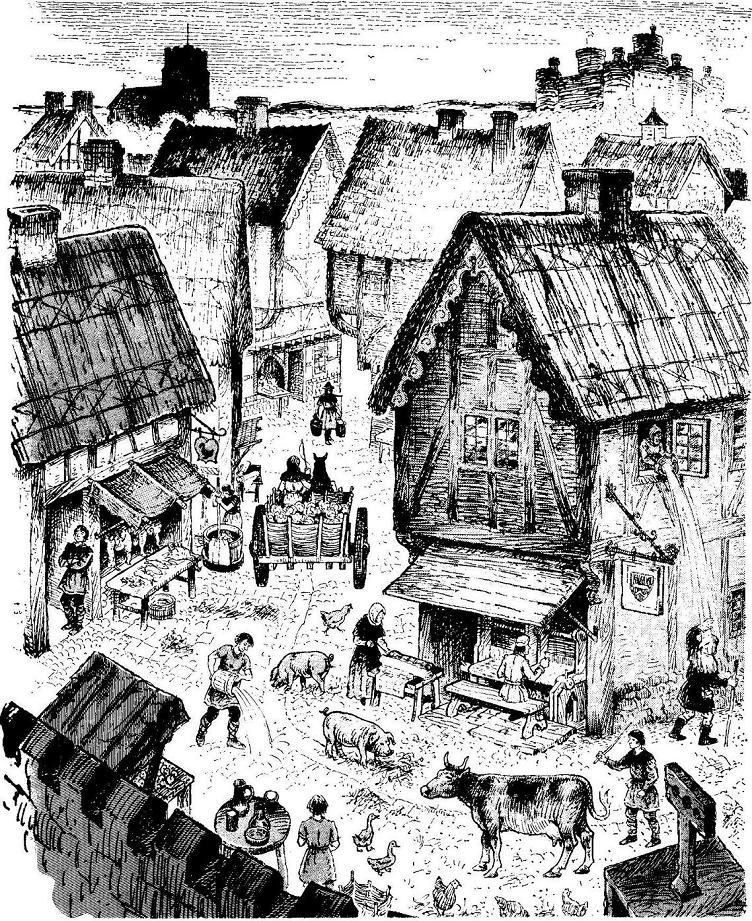
Dirty Old Town?

1 Life in a Medieval Town
This painting was commissioned for my 1997 textbook The Middle Ages 1066-1500. It is by a modern artist, but it is very carefully researched – everything you can see happening in the picture actually happened some time, somewhere, in a medieval town.
Many of the events shown in the picture are from the records of medieval trials; does this mean the picture is therefore a reliable portrayal of life in a medieval town?

Introduction
If you read any children's history book, it will probably tell you that medieval towns were filthy. My view has always been that medieval people were victims of a smear campaign by the Renaissance, that medieval towns were relatively clean compared to the 16th and 17th centuries, and VERY clean compared to the 18th and 19th centuries ... but that is just my theory, and you do not need to believe me!
This webpage will help you decide whether medieval towns were as dirty as they are painted.
Study this webpage, then answer the question sheet by clicking on the 'Time to Work' icon at the top of the page.
Links:
The following websites will help you research further:
Medieval hygiene:
• Traditonal but lively view from
Historic Scotland
• Rosalie's webpage on
women's cleanliness in the Middle Ages
• A difficult webpage on
baths in the Middle Ages
2 A medieval town drawn by the modern artist Norman Meredith (1969).

3 An extract from History Alive I (1970), a textbook aimed at Year 7 pupils by the children's writer Peter Moss; he made history easy-to-understand, using simple descriptions and cartoons drawn by George B Hamilton.
The streets were sometimes cobbled, sometimes covered with gravel, but more often just a mud track and were always filthy. Household waste, sewage, leather parings, rotting vegetables and any other rubbish was thrown into the gutter and ran down the centre. Here it accumulated in rotting, rat and germ-infested stinking heaps until a violent rainstorm washed it further on.
4 A description by L Hartley, History of Medicine (1984) - a textbook aimed at less-able pupils in Key Stage 4.
The streets often had open sewers running down the middle of them. These sewers became clogged with rubbish and excrement thrown from the windows. Pigs, dogs and rats often roamed through the streets. Towns such as London sometimes tried to clean up the streets, but not very often. People had no idea that dirty conditions could lead to disease.
5 An extract from the Book of Customs (1321) - a book of court-cases brought against people in London in the Middle Ages.
Next case heard by the wardmen of the city of London: the lane called Ebbegate was a right of way for all men until it was blocked by Thomas at Wytte and William de Hockele, who got together and built latrines which stuck out from the walls of the houses. From these latrines human filth falls on the heads of the passers-by.
6 The first national sanitation law passed in England (1388).
For that so much dung and filth of garbage and entrails be cast and put in ditches, rivers and other waters, so that the air there is grown greatly corrupt and infected, and many intolerable diseases do daily happen ... it is accorded and assented that the proclamation be made as well in the city of London, as in other cities where it be needful, that they who do cast and lay all such annoyances, dung, garbages, entrails, and other ordure, in ditches, rivers, waters, and other places, shall cause them utterly to be removed, avoided, and carried away, every one on pain to pay a fine of £20.
7 A letter from the Dutch writer Erasmus to an English doctor (1524) – Erasmus was giving his ideas about how to stop plagues.
Almost all the floors are made of clay and rushes from the marshes, so carelessly removed that the bottom layers sometimes remain for 20 years, keeping there below spittle and vomit and urine of dogs and men, beer that has been thrown down, leftovers of fishes and filth unnamable...
It would help also if people made the council keep the streets less dirty from filth and urine.
8 An extract from Medieval Medicus - a book written by EJ Kealey in 1981 and aimed at university students.
Archaeology shows that in 12th century England well-off townhouses had lead pipes and stone drains. Latrines were often neatly-lined in wood or stone, periodically cleaned out, and carefully dug some distance from the houses.
Poorer houses were often swept quite clean, with none of the litter they are supposed to have had (which you find so often in Roman houses).
9 Although houses did not have bathrooms or running water, most towns had public bathhouses (Paris had 26 in 1292) and some people bathed twice a day. There are MANY pictures of bathhouses from the medieval period, though you will see that some of them were little better than brothels.

10 This extract was written by Mrs JR Green, Town Life in the Fifteenth Century (1894)
In 1421, the water-supply of Southampton was undertaken by the council, and new lead pipes provided by the grant of a businessman who had left his money 'for the good of his soul'. An aqueduct was built at great expenses in 1428; it took 261 days' work and was made of great stones, with loads of chalk, quicklime, pitch, resin, solder, wax and wood.
In 1490 a new well was made with a 'watering-place for horses and a washing-place for women'.